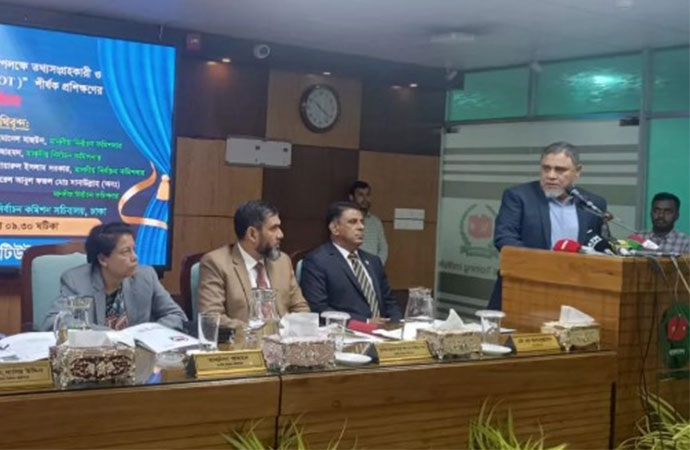Reportage

People wade through flooded waters in Sylhet, Bangladesh, Saturday, June 18, 2022. At least 18 people have died as floods cut a swatch across northeastern India and Bangladesh, leaving millions of homes underwater. Both countries have asked the military to help with the severe flooding, which could worsen because rains are expected to continue over the weekend. Photo: AP/UNB
The monsoon floods that ravaged the Sylhet region have turned the studies of over 455,000 students in 1522 institutions uncertain as they lost their books and educational materials amid no sign of immediate reopening of their classes.
The authorities are compiling a report on the extent of damages caused by the worst floods to hit the region in living memory this month, according to Prof Shahedul Khabir Chwodhury, director of Department of Secondary and Higher Education (DSHE), Sylhet.
Reports received from the evaluation wing of DSHE, 100 educational institutions in the flood-hit upazilas under Sylhet division can be operated fully while 100 can reopen partially.
Besides, over 500 educational institutions remained closed in the flood-hit areas while 450 others are still used as shelter homes for flood victims, Shahedul said. The textbooks of many students have been washed away in the flood-affected areas.
The examinees of Secondary School Examination (SSC) examinations are worried about sitting for the exams as flood waters damaged their books.
Tofazzal Hossain, a student of Salutikor High School in Sadar upazila, said "My books were washed away by the flood water and I have failed to collect replacement from the local school as they have no extra copies."
Shihab Ahmed, a class VII student and resident of Rayergaon area of Sadar upazila, said "Flood water entered into our houses on June 17 and I am yet to collect new books and copies. When we returned home on June 24 and I found all of my books and copies damaged."
About 80 per cent areas in Sylhet districts were flooded while over 21 lakh people got stranded in the second wave of the deluge on June 15.
Abdul Mannan Khan, director of the Department of Secondary and Higher Education (DSHE), Sylhet said directives have already been given to make a list of affected students and books will be provided following the list.
He also urged the students to manage their books from their friends if possible.
Pratul Chandra, Primary Education Officer of Goainghat upazila, said 50 per cent books, which were kept in stock, have been damaged.
"The educational institutions in the upazila will be reopened after Eid-ul-Azha in the second week of July. Steps will be taken after assessing the extent of damage of the institutions after their reopening," he said.
In another development floods claimed three more lives in different parts of the country in 24 hours till Tuesday morning, raising the total fatalities to 87.
Among the deceased, 61 people have died by drowning and two from snake bites, one from diarrhoea, 14 from lightning strike and nine of other reasons.
The total deaths were recorded from May 17 to June 28.
According to the Flood Forecasting and Warning Centre, all the major rivers in the country except the Teesta were falling.
4th wave coming?
When people in the flood-ravaged northeastern region still struggling to survive, weather experts are predicting another round of flood in the region due to rains in the next few days.
Sylhet Water Development Board sources said heavy to moderate rains are likely in Sylhet division in the next few days.
"If the rains continue in India, the onrush of water from the upstream may inundate Sylhet region," said AKM Niloy Pasha, sub-divisional engineer of Sylhet Water Development Board.
Besides, Flood Forecasting and Warning Centre of the Bangladesh Water Development Board (BWDB) said there is chance of heavy rainfall at places in the northern and north-eastern Bangladesh along with Assam, Meghalaya and Sub-Himalayan West-Bengal (Jalpaiguri, Sikkim) of India in next 24-48 hours.
Flood situation in the northern region and low-lying areas of the central region including Sylhet and Sunamganj may slightly deteriorate, it said in their latest warning.
However, the flood situation is unlikely to worsen further after mid-July, reports Bangladesh Weather Observation Team - BWOT, an independent weather research group.
In Sunamganj, the water levels of different rivers of the district including Surma, Jadukata, Chilai, Khasiyamara, Chela are rising again as the district recorded 196mm rainfall in the last 24 hours.
The Surma River was flowing 83cm above the danger level in Chhatak upazila, 12cm above the danger level in Dirai upazila Wednesday noon. However, the river was flowing 14cm below the danger level in Sunamganj town, according to Sunamganj Water Development Board. The water level of the Surma River has increased by 22 cm in the last two days, it added.
Meanwhile, it rained in Sylhet district on Tuesday morning and night, worrying the local people that the flood situation will prolong for more days.
After about two weeks, the floodwaters receded in most areas of Sylhet. But houses and roads in Balaganj, Osmaninagar, Fenchuganj, Zakiganj, Beanibazar, Jaintapur and Gowainghat upazilas of Sylhet are still under floodwaters.
The residents of these areas are now struggling to recover damages from flood after returning home from shelters.
The two spells of flood have already damaged Boro and Aman crops as well as caused huge losses in various sectors including agriculture, fisheries and tourism.
Sylhet: 40,000 houses destroyed, 3 million left homeless
Over 30 lakh people have been rendered homeless and as many as 40,000 houses were destroyed in the recent floods in Sylhet, officials said on Thursday. All the 13 upazilas of the district, including five municipalities, have been affected.
According to the local administration, over 2.5 lakh people are living in over 610 shelter homes across the district.
Ahsanul Alam, an assistant commissioner at Sylhet deputy commissioner's office, said that a total of 40,019 houses have been fully or partially destroyed in the floods.
A list of the affected families has been sent to the Disaster Management and Relief Ministry so that they could be given some assistance, he said.
According to the Flood Forecasting and Warning Centre of the Bangladesh Water Development Board (BWDB), the flood situation in Sylhet and Sunamganj districts may slightly deteriorate as the major rivers in the country are showing a rising trend.
About 80 percent of the territory under Sylhet district was flooded while over 21 lakh people got stranded in the second wave of the deluge on June 15.
Major rivers swelling again
Major rivers in Sylhet including the Surma and the Kushiyara have started swelling again due to incessant rains since Tuesday (Jun. 28), creating panic among local people already devastated by what they described as 'the worst flood in living memory'.
The Surma and the Kushiyara rivers were flowing above their danger levels at some points Thursday morning following heavy downpour in two days since Tuesday.
The floodwaters in the areas adjacent to Surma, Dhalai, Piyain, Sari and Lova river banks had almost receded by Tuesday afternoon.
But the Surma River is flowing 0.84cm above the danger level at Kanaighat point while the Kushiyara is flowing 1.12cm above the red level at Amalshid point Thursday morning, according to Sylhet Water Development Board.
The water level of the Kushiyara River is in rising trend at Sheola and Fenchuganj points.
AKM Niloy Pasha, sub-divisional engineer of Sylhet Water Development Board, said, "It is raining in Sylhet as well as upstream. As a result, the water of these rivers is rising."
In Sunamganj, it started raining again from Monday after a week. Rivers are swelling again due to onrush of water from upstream triggered by rains in Meghalaya and Cherrapunji of India.
The water level of the Surma River increased by 32cm in three days.
According to Sunamganj Water Development Board, the Surma river was flowing 3 cm below the danger level near Sunamganj town at 12 noon on Thursday.
However, the river is flowing 83cm above the danger level in near Chhatak upazila as the district recorded 195mm rainfall in the last 24 hours.
The Jamuna River has also started swelling in Sirajganj.
The water of the Jamuna has increased by 20 cm at Sirajganj point. But the river is flowing 80 cm below the danger level at this point.
At Kazipur point, water level of the Jamuna has increased by 14 cm and the river is flowing 70 cm below the danger level this morning, said Sirajganj Water Development Board Sub-Divisional Engineer (Headquarters) Nasir Uddin.
However, Shafiqul Islam, executive engineer of Sirajganj Water Development Board, said there is no possibility of flood in this district even if the water level of the Jamuna continues to increase for the next 2/3 days.
Meanwhile, Flood Forecasting and Warning Centre of the Bangladesh Water Development Board (BWDB) said there is chance of heavy rainfall at places of the northern and northeastern Bangladesh along with Assam, Meghalaya and Sub-Himalayan West Bengal (Jalpaiguri, Sikkim) of India in next 24 hours.
As a result, the major rivers of northern Bangladesh (Teesta, Upper Atrai, Dharla, Dudhkumar, Upper Karotoa, Tangon, Punarbhaba and Kulikh) may rise rapidly during this period, it added.
The water level of the Teesta river at Dalia Point, Dharla river at Kurigram point and Dudhkumar river at Pateswari point may remain close to danger level in next 24 hours.
Flood situation in Kurigram and Dinajpur districts of northern region and Sylhet, Sunamganj, Netrokona, Kishoreganj and Brahmanbaria districts of northeastern region may remain steady in next 24 hours, it added in their latest report.

























Leave a Comment
Recent Posts
23rd DIFF concludes; ‘Priyo Ma ...
The 23rd Dhaka International Film Festival (DIFF) concluded on Sunday, ...
Gallery Chitrak launches Syed ...
The publication ceremony of the book "Rafiqun Nabi'r Chitraba ...
‘Power of Pain and Pathos 2’: Embassy of the Netherl ..
‘Echoes In Form’: Rediscovering Shyamal Chowdhury th ..
SeaKeepers shows the way for plastic waste managemen ..
Exploring Sundarbans: A sense of wonder and global r ..